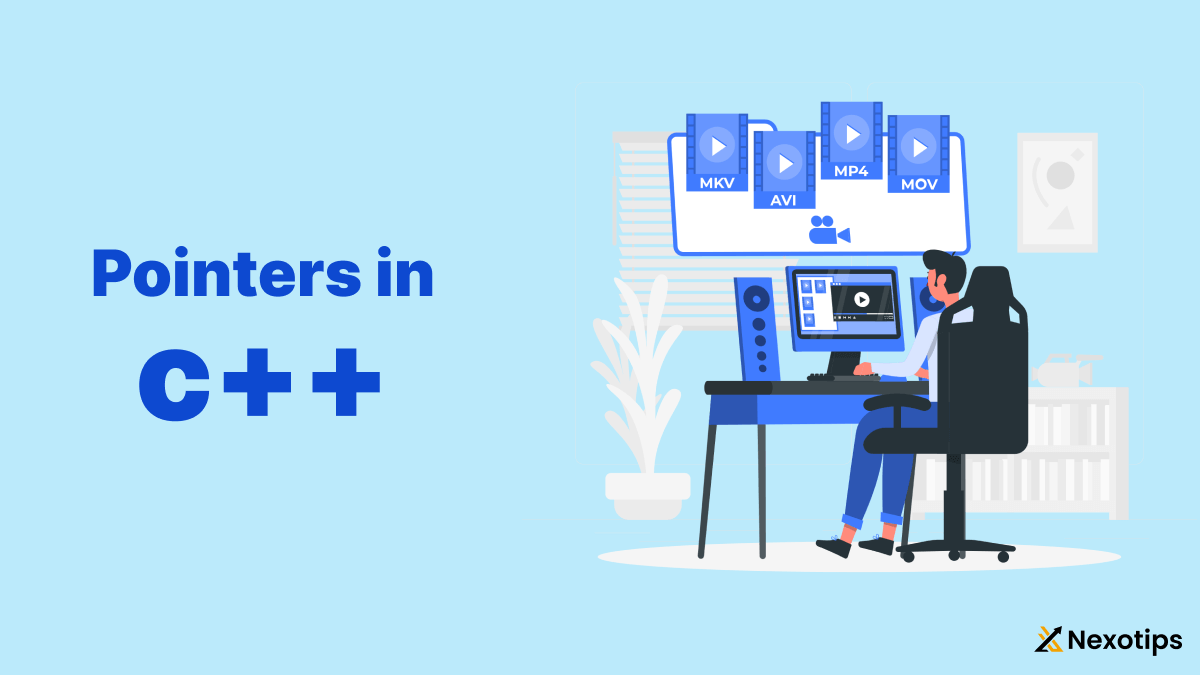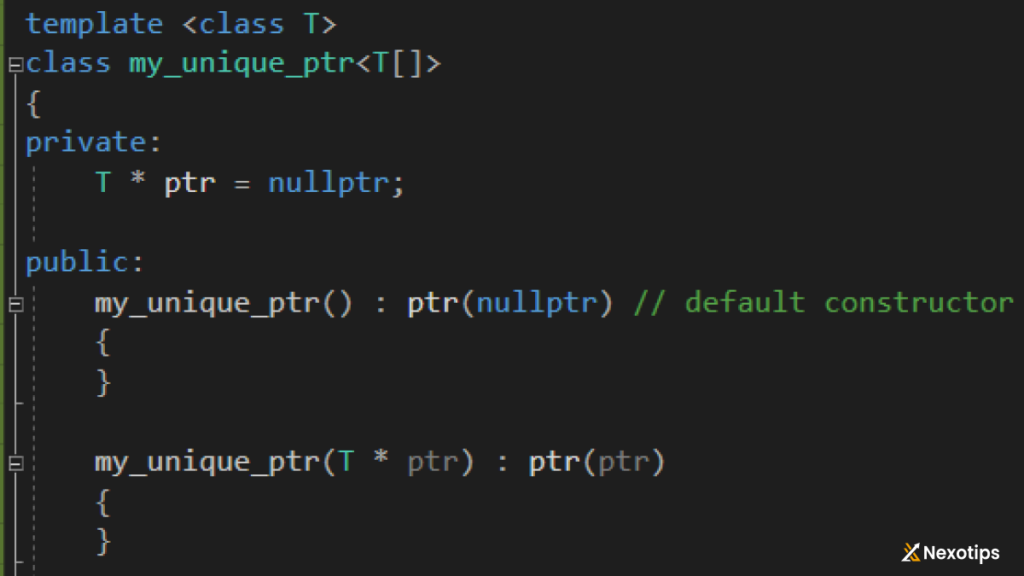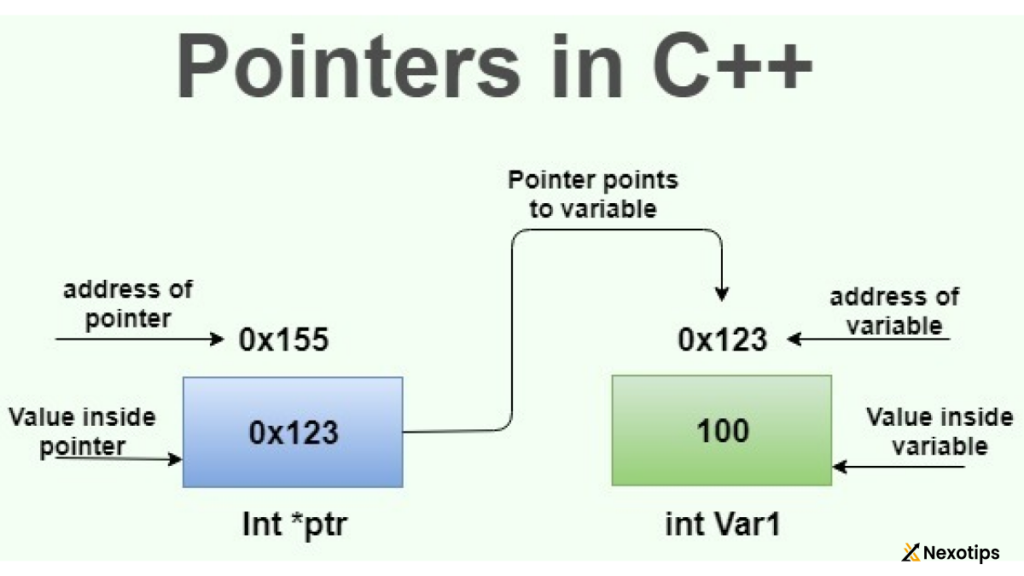
C++ Pointers : A Comprehensive Guide for 2024
1. Introduction
Pointers are a unique feature of C++ that offer a high level of flexibility and control over memory. Unlike regular variables that store data, It store the memory addresses of other variables. This distinction is crucial for understanding how It operate and their role in C++ programming.
Why Use Pointers?
- Dynamic Memory Management: They are essential for allocating and deallocating memory dynamically during program execution.
- Efficient Array Handling: It provide a more efficient way to manage and manipulate arrays.
- Data Structures: They are fundamental in implementing complex data structures such as linked lists, trees, and graphs.
- Performance: It can lead to performance improvements by reducing the overhead of passing large objects to functions.
2. Pointer Declaration and Initialization
Declaration
To declare a pointer, you specify the type of the variable it points to, followed by an asterisk (*) and the pointer’s name. Here’s the basic syntax:
int *ptr; // ptr is a pointer to an integer
Initialization
A pointer must be initialized to point to a valid memory address. This can be the address of a variable or a memory location obtained through dynamic allocation.
int var = 10;
int *ptr = &var; // ptr now holds the address of var
Null Pointers
A null pointer refers to a pointer that does not reference any valid memory location. It is a good practice to initialize It to nullptr if they are not assigned any address.
int *ptr = nullptr;
Void Pointers
Void pointers are generic pointers that can point to any data type. However, they cannot be dereferenced directly without casting.
void *ptr;
int var = 10;
ptr = &var; // ptr can hold the address of an int variable
3. Pointer Arithmetic
It support arithmetic operations such as addition and subtraction. Pointer arithmetic relies on the size of the data type that the pointer is referencing.
Increment and Decrement
When you increment a pointer, it points to the next memory location of its type. Similarly, decrementing a pointer points to the previous memory location.
int arr[5] = {1, 2, 3, 4, 5};
int *ptr = arr; // ptr points to the first element of arr
ptr++; // ptr now points to the second element of arr
ptr--; // ptr now points back to the first element of arr
Addition and Subtraction
You have the ability to increase or decrease an integer value to/from a pointer.
int *ptr = arr;
ptr = ptr + 2; // ptr now points to the third element of arr
ptr = ptr - 1; // ptr now points to the second element of arr
4. Pointers and Arrays
Arrays and pointers are closely related in C++.
The name of an array acts as a constant pointer to the first element in the array.
Accessing Array Elements Using Pointers
You can use It to access and manipulate array elements.
int arr[5] = {1, 2, 3, 4, 5};
int *ptr = arr;
for (int i = 0; i < 5; ++i) {
std::cout << *(ptr + i) << " "; // Outputs: 1 2 3 4 5
}
Pointer to an Array
You can also have pointers to entire arrays.
int (*ptr)[5] = &arr;

5. Pointers and Functions
It can be used to pass variables to functions by reference, allowing the function to modify the original variable.
Passing Pointers to Functions
When passing It to functions, you can modify the actual argument used to call the function.
void increment(int *ptr) {
(*ptr)++;
}
int main() {
int var = 10;
increment(&var);
std::cout << var; // Outputs: 11
return 0;
}
Returning Pointers from Functions
Functions can also return It . However, you must ensure the pointer returned points to valid memory.
int* createArray(int size) {
return new int[size];
}
6. Dynamic Memory Allocation
Dynamic memory allocation is one of the primary uses of It in C++. It allows you to allocate memory at runtime using the new and delete operators.
Allocating Memory
The new operator allocates memory of a specified type and returns a pointer to it.
int *ptr = new int; // Allocates memory for an integer
*ptr = 5;
Deallocating Memory
The name of an array acts as a constant pointer to the first element in the array.
delete ptr; // Deallocates the memory
Allocating Arrays
You can also allocate memory for arrays dynamically.
int *arr = new int[10]; // Allocates memory for an array of 10 integers
Deallocating Arrays
To deallocate memory for arrays, use delete[].
delete[] arr; // Deallocates the memory for the array
7. Pointers to Pointers
Pointers to pointers are used in situations where you need to store the address of a pointer. They are commonly used in dynamic multi-dimensional arrays and in passing It to functions.
Declaration and Initialization
int var = 10;
int *ptr = &var;
int **pptr = &ptr; // pptr is a pointer to a pointer
Accessing Value Using Pointer to Pointer
std::cout << **pptr; // Outputs: 10
8. Function Pointers
Function pointers are pointers that point to functions. They are useful for callback functions and implementing function tables.
Declaration and Initialization
void func() {
std::cout << "Hello, World!";
}
void (*fptr)() = func; // fptr is a pointer to a function
Calling a Function Using a Function Pointer
fptr(); // Calls func
Passing Function Pointers to Functions
void execute(void (*func)()) {
func();
}
int main() {
execute(func); // Calls func
return 0;
}
9. Smart Pointers
They are a feature of C++11 that provide automatic memory management. They help in preventing memory leaks by ensuring that dynamically allocated memory is properly deallocated.
Types of Smart Pointers
- std::unique_ptr: A unique ownership smart pointer.
- std::shared_ptr: A reference-counted smart pointer.
- std::weak_ptr: A weak reference smart pointer to be used with
std::shared_ptr.
Using std::unique_ptr
std::unique_ptr<int> uptr(new int(5));
std::cout << *uptr;
Using std::shared_ptr
std::shared_ptr<int> sptr(new int(5));
std::cout << *sptr;
Using std::weak_ptr
std::shared_ptr<int> sptr(new int(5));
std::weak_ptr<int> wptr = sptr; // wptr is a weak reference to sptr

10. Common Pitfalls and Best Practices
Dangling Pointers
A hanging pointer refers to memory that has been released. Accessing such a pointer leads to undefined behavior.
Memory Leaks
Failing to deallocate memory results in memory leaks. Always ensure that dynamically allocated memory is properly deallocated.
Best Practices
- Initialize It : Always initialize It to
nullptror a valid address. - Use Smart Pointers: Prefer smart pointers over raw pointers for automatic memory management.
- Avoid Pointer Arithmetic: Minimize the use of pointer arithmetic to avoid errors.
- Check for Null : Always check if a pointer is
nullptrbefore dereferencing.
11. Conclusion
They are a powerful and essential feature of C++ that provide flexibility and control over memory management. Understanding It is crucial for efficient C++ programming, particularly in dynamic memory allocation, array manipulation, and implementing complex data structures. By mastering It and following best practices, you can harness their full potential while avoiding common pitfalls such as memory leaks and dangling It . This comprehensive guide aims to provide a solid foundation for working with It in C++, enhancing your skills and confidence in using this powerful feature effectively.
Read More : Comprehensive Guide To C++ Enums : Enhancing Code Clarity And Safety
